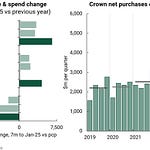TL;DR: An unseasonally early icy blast at the same time as some long-overdue maintenance almost caused Aotearoa-NZ’s electricity system to black out this week. That’s because a quadropoly of gentailers1 have prioritised paying dividends from their rising profits and adding debt over investing in 1.5 GigaWatts of new wind farms that were already consented over the last decade.
Official inquiries, the OECD, consumer and worker advocates, and countless frustrated and/or failed independent electricity retailers have called on the Government to break up or regulate the quadropoly in a way that would create much more competition and restrain the super profits, super dividends and under-investment. That extra competition would, in turn, spark2 innovation by new competitors to grow and match electricity demand with supply in the right places. That would both avoid blackouts and help transition away from coal, gas, diesel and petrol use to an (almost) fully renewable electricity and transport systems that cut living costs and are much more resilient to climate extremes and geopolitical drama.
Yesterday I spoke to Rewiring Aotearoa CEO Mike Casey and Octopus Energy NZ Chief Operating Officer Margaret Cooney about the current state of our electricity market and what could be done to fix it. Our conversations are included in full in the video above, and audio podcast above, which is available to all.
Casey talked about how he earned extra money by exporting power into the grid at sky-high prices from the solar panels and batteries he installed to fully electrify his cherry orchard in Cromwell. Cooney talked about how Octopus Energy UK pays customers to reduce demand and uses automation to match supply and demand. She also talks about a way to make the market more competitive and viable for independent retailers buying from the wholesale market.
(Paying subscribers can see more detail and analysis below the paywall fold and in the video above. The audio version is available immediately to all subscribers. We’ll open it up for public reading, listening and sharing if we get over 100 likes.)
An explainer: why we almost blacked out and how to fix it
So what actually happened this week?
Transpower warned on Thursday of potential blackouts on Friday morning because an unseasonal cold snap was happening at the same time as long-planned and overdue maintenance, along with a lack of gas supplies. It asked both households and industrial users to voluntarily reduce their use of power. It also worked with some lines companies to directly switch off hot water cylinders through a system known as ‘ripple control’. Meanwhile, wholesale prices rose as much as 50-fold from $270 per MegaWatt/hour to $5,000 per MegaWatt/hour (27c per KiloWatt hour to $5 per KiloWatt hour) on Wednesday and Thursday, also discouraging those industrial users with prices based off wholesale prices.

That plea and the above market signals worked, at least for yesterday morning. Transpower said yesterday about 260 MegaWatts worth of demand had been reduced, which is equivalent of the demand of a city as big as Hamilton.
But the broader problem remains of why we don’t have enough generating capacity, batteries and demand management tools to make a cold snap at the wrong time of the year business as usual.
Why didn’t the gentailers build more capacity?
In my view, it’s because the industry is not competitive enough to allow innovative new entrants to come in with new ideas and technology, and because the big four gentailers were able to take advantage of their super profits to hand over big dividends to shareholders, especially the biggest one: the Government under both flavours of politicians. Here’s a summary of what went wrong with electricity industry deregulation and privatisation over the last 30 years, via Paul Fuge at ConsumerNZ.
Here’s what happened to generation capacity, dividends, capital returns and investment. The prioritisation of dividends and the stagnation of generating capacity was especially pronounced from 2013 to 2021.



Did consenting issues stop them from investing?
‘No’ is the clear answer. There are currently 1.551 GigaWatts of wind projects already consented, according to NZ Wind Energy Association data. That’s 60% more capacity than is already built and would be enough to replace all the coal and gas currently still be used. Many have been consented and ready to go for a decade.
Some generators have argued wind and solar are not as reliable or as immediate a source of electricity as coal and gas, and therefore they cannot be like-for-like or useful substitutes. That is true in a world without batteries, but that is rapidly changing.
So how do we fix this?
Some investors and independent electricity players who have been frustrated with waiting for a competitive market to be developed have recently started using plummeting prices of solar panels and batteries to build grid-scale solar farms and batteries.
Here’s a couple of examples:
Lodestone Energy has already built three solar farms, including this one most recently in Northland. It plans to build 320 MegaWatts of capacity, which would be enough to power 50,000 homes.
In March this year, WEL Networks and Infratec opened their 35 MW battery at Rotohiko near Huntly, which is connected to the Transpower grid and has 16 battery modules, eight inverters and four transformers. It can then charge the batteries when power prices are cheap and then sell it at peak times to make a profit.
It depends on the Government
Energy Minister Simeon Brown blamed the previous Labour Government’s decision to block new exploration for oil and gas, but the true blame is closer to home. Treasury has demanded high dividends to ensure deficits and mortgage rates are as low as possible.
There are no moves afoot to direct the gentailers to increase investment, or to either structurally separate or force transparency from the gentailers about what their retail divisions pay their wholesale divisions for power. The current limits on lines companies retailing power is also keeping the competition wolves from the gentailers doors.
Until independent retailers believe the wholesale market is fair and reliable and the Government encourages and incentivises households and businesses to ‘go electric’, it will be hard to introduce the sort of innovative tech and systems to roll out substantial solar and battery networks.
Mā te wā
Bernard
The big four electricity generators who also operate as retailers (gentailers) are the 51%-state owned Meridian, Mercury and Genesis, plus the fully privatised and also NZX-listed Contact. A CTU report published in December found the gentailers paid $10.8 billion in dividends while investing $4.5 billion on plant and equipment over the previous decade. That meant capacity increased just 1% over a period when multiple official reports recommended a doubling of generation to prepare for increased renewable electricity demand. The gentailers paid out total dividends and capital returns of $2.41 for each dollar invested in renewable generation.
See what I did there.


















Share this post